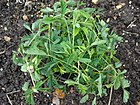Note: This is a project under development. The articles on this wiki are just being initiated and broadly incomplete. You can Help creating new pages.
Mimosa pudica - Lajjika
Lajjika is an annual to perennial, more or less prostrate creeping plant. The plant can grow up to 1 metre tall. The plant is gathered from the wild for local medicinal use. It is cultivated as a green manure and for soil stabilization and is sometimes also cultivated for its uses in folk medicine. Probably arose in the Neotropics, but now Pantropical.
Uses
Female reproductive disorders, Diarrhea, Bleeding disorders, Ulcers, Inflammation, Gastritis, Fatigue, Asthma, Skin diseases.[1]
Parts Used
Chemical Composition
Mimosa pudica contains various compounds, including "alkaloids, flavonoid C-glycosides, sterols, terenoids, tannins, saponin and fatty acids". The roots of the plant have been shown to contain up to 10% tannin etc.[3]
Common names
| Language | Common name |
|---|---|
| Kannada | Naachike gida, Naachike mullu |
| Hindi | Chui mui, Lajalu |
| Malayalam | Thendarmani, Thotavadi |
| Tamil | Alavananki |
| Telugu | Atthapatthi, Lajjavanthi |
| Marathi | NA |
| Gujarathi | NA |
| Punjabi | NA |
| Kashmiri | NA |
| Sanskrit | Ajalikalika, Alambusa |
| English | Sensitive plant |
Properties
Reference: Dravya - Substance, Rasa - Taste, Guna - Qualities, Veerya - Potency, Vipaka - Post-digesion effect, Karma - Pharmacological activity, Prabhava - Therepeutics.
Dravya
Rasa
Tikta (Bitter), Kashaya (Pungent)
Guna
Laghu (Light), Rooksha (Dry)
Veerya
Sheeta (cold)
Vipaka
Katu (Pungent)
Karma
Pitta, Kapha
Prabhava
Habit
Identification
Leaf
| Kind | Shape | Feature |
|---|---|---|
| Bipinnate | Alternate | Borne on stalks (i.e. petioles) 15-60 mm long. They consist of one or two pairs of branchlets (i.e. pinnae) that often have a covering of stiff, prickly, bristles. |
Flower
| Type | Size | Color and composition | Stamen | More information |
|---|---|---|---|---|
| Bisexual | Axillary | Pink | 4 | The pink or purplish coloured flowers are arranged in small, fluffy, globular or egg-shaped (i.e. ovoid) clusters (9-15 mm across). Flowering from August to April |
Fruit
| Type | Size | Mass | Appearance | Seeds | More information |
|---|---|---|---|---|---|
| A Pod | 10-25 mm long and 3-6 mm wide | The oblong and flattened seed pods are borne in clusters at the ends of the flowering stalks. | Fruiting from August to April |
Other features
List of Ayurvedic medicine in which the herb is used
Where to get the saplings
Mode of Propagation
How to plant/cultivate
Seed - it has a hard seedcoat and may benefit from scarification before sowing to speed up germination.[7]
Commonly seen growing in areas
Photo Gallery
References
- ↑ Uses
- ↑ ”Karnataka Medicinal Plants Volume-3” by Dr.M. R. Gurudeva, Page No.1076, Published by Divyachandra Prakashana, #6/7, Kaalika Soudha, Balepete cross, Bengaluru
- ↑ Chemical composition
- ↑ Vernacular names
- ↑ Botonic description
- ↑ Ayurvedic preparations
- ↑ Cultivation details
External Links
- Ayurvedic Herbs known to be helpful to treat Female reproductive disorders
- Ayurvedic Herbs known to be helpful to treat Diarrhea
- Ayurvedic Herbs known to be helpful to treat Bleeding disorders
- Ayurvedic Herbs known to be helpful to treat Ulcers
- Ayurvedic Herbs known to be helpful to treat Inflammation
- Ayurvedic Herbs known to be helpful to treat Gastritis
- Ayurvedic Herbs known to be helpful to treat Fatigue
- Ayurvedic Herbs known to be helpful to treat Asthma
- Ayurvedic Herbs known to be helpful to treat Skin diseases
- Herbs with Whole plant used in medicine
- Herbs with Root used in medicine
- Herbs with Leaf used in medicine
- Herbs with common name in Kannada
- Herbs with common name in Hindi
- Herbs with common name in Malayalam
- Herbs with common name in Tamil
- Herbs with common name in Telugu
- Herbs with common name in Sanskrit
- Herbs with common name in English
- Habit - Herb
- Index of Plants which can be propagated by Seeds
- Herbs that are commonly seen in the region of Tropical area
- Herbs that are commonly seen in the region of Sub tropical area
- Herbs
- Herb
- Ayurvedic herbs that don't have seed photos
- Fabaceae





